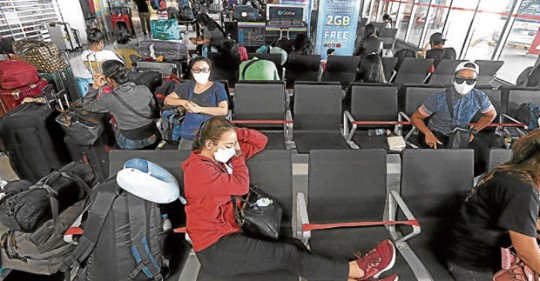MANILA, Philippines — Filipinos stranded in different parts of the country and overseas are having difficulty going home due to confusing regulations and the government’s lack of capability to test for the new coronavirus.
A week after lockdown restrictions were loosened on June 1 in Metro Manila, airlines and shipping companies remain unclear about where they can operate.
Moreover, international traffic such as returning Filipino migrant workers are capped at 600 a day at Ninoy Aquino International Airport (Naia), which handled more than 200,000 travelers before the new coronavirus pandemic.
The problems emerged during an online meeting on Friday called by Rep. Edgar Sarmiento, head of the transportation committee of the House of Representatives.
‘Work it out’
At one point, Sarmiento expressed frustration at the lack of coordination between the national government and local governments, telling them to “work it out.”
“Please understand that airline companies and almost all industries—[all of] humanity—for almost two and half months, practically never did anything but to be quarantined,” Sarmiento said in an exchange with Interior Undersecretary Rico Echiverri.
“Now the chair doesn’t have the face anymore on how to explain that, by two months of not doing anything, here we are again,” Sarmiento said. “We want to have consistency.”
Echiverri explained that local governments did not immediately adopt new guidelines from the Inter-Agency Task Force on Emerging Infectious Diseases, the temporary government body overseeing the Duterte administration’s response to the pandemic.
“Once a guideline is issued by the [task force], in the first two weeks, local governments tend to have their own interpretation,” Echiverri said. “But once they are reminded by the regional directors, they tend to follow at once.”
During the gap in implementation, airlines, shipping companies and travelers suffer the consequences. On June 2, for example, as airlines were selling seats, the Civil Aeronautics Board announced that they could fly only to destinations where the local governments allowed the resumption of air traffic.
Flights can be rejected
The rule allows local governments to reject flights from cities with coronavirus cases or impose additional requirements on top of a medical certificate and authority to travel.
As Metro Manila is the epicenter of the local coronavirus outbreak, the June 2 flight of Cebu Pacific to General Santos City was canceled the night before, but the passengers on that flight did not know it until they began to check in at Naia. The flight was eventually allowed to proceed later in the day after the airline appealed the cancellation.
Jim Sydiongco, director-general of the Civil Aviation Authority of the Philippines, told the House hearing that only 13 of the country’s 40 commercial airports were taking scheduled domestic flights.
Apart from Naia and Clark International Airport in Pampanga, the others are the airports in Romblon, Naga, Cauayan, Palanan, Marinduque, Laguindingan, Camiguin, Dipolog, Pagadian and General Santos.
The airports in Davao, Cotabato and Zamboanga are opening Monday, while those in Iloilo and Tacloban will open next Tuesday, Sydiongco said.
Migrants are having difficulty going home because the 600 limit at Naia is tied to the capacity of the Department of Health (DOH) to test for the new coronavirus, said Roberto Lim, vice chair of Air Carriers Association of the Philippines.
Lim suggested that the government open up more gateways for international traffic “so we can expand the capacity to process the repatriation of [migrants] and also the arrival of international passengers [who] are qualified.”
More than 21,000 cases
The Philippines has more than 21,000 confirmed coronavirus cases, over 1,000 of which have led to deaths.
On Sunday, the DOH reported 555 new cases, bringing the national total to 21,895. Of the new cases, 378 were verified to have tested positive during the last three days, while 177 were detected at least four days ago but were just validated by the DOH Epidemiology Bureau.
The DOH also reported that 89 more patients had recovered, bringing the total number of survivors to 4,530.
But the death toll increased to 1,003, it said, with the deaths of nine more patients.
The lawmakers hope to solve some safety problems to ease the worries of local governments over the spread of the coronavirus.
During the hearing on Friday, they pushed a resolution that would allow the Department of Transportation to require air, sea and land carriers to have detailed seat plans.
The seat plans will aid local governments in contact tracing, said Bacolod City Rep. Greg Gasataya, who filed the resolution. —With a report from Tina G. Santos
Disclaimer: The comments uploaded on this site do not necessarily represent or reflect the views of management and owner of Cebudailynews. We reserve the right to exclude comments that we deem to be inconsistent with our editorial standards.

